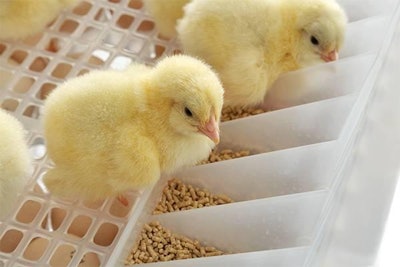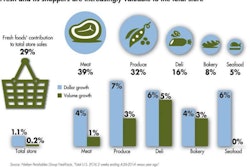With a weekly output of 1.8 million broiler chicks, Lagerwey is the biggest commercial hatchery in the Netherlands. Centrally located near the village of Lunteren, the company supplies day-old chicks to growers across the country, as well as to Belgium and to the west of Germany.
Lagerwey has seen strong growth in demand for its chicks and, in early 2014, started work on a 3,000-square-meter extension to its hatchery. Chick production at the new facilities started this year.
To date, six new hatchers with a capacity to hatch 95,000 eggs have been brought into operation, but there are plans to further increase capacity and produce 3 million chicks per week.
However, this expansion in production has not only seen the number of chicks increase, the company has invested in new technology to produce chicks in a way that it has not done before.

Lagerwey hatchery general manager Wim van de Vegte believes the new system allows the hatchery and its clients to be competitive and meet changing consumer demand.
“In our view, the current, common way of hatching hasn’t changed much in the past 50-60 years. Yet, the world has changed, and new legislation on poultry production has come into place.” Lagerwey general manager Wim van de Vegte said.
Various options were considered, but eventually the company decided to return to HatchTech, the company that built the previously existing part of the hatchery 15 years ago.
“Our decision to invest in HatchTech’s HatchCare system was a logical choice. We have had good experiences with HatchTech, which is located very near our premises and can instantly service our machines, but more importantly, they have a different and innovative view on hatchery design.”
Evolving consumer demands
Van de Vegte continues that the company was not simply looking for technical solutions.
“Animal welfare has truly become an issue in the western world, particularly in the Netherlands. Moreover, the modern consumer is critical and fears meat may originate from animals that have been treated with antibiotics.
“In the European Union, and particularly, in the Netherlands, there’s a clear tendency to substantially decrease the use of antibiotics in poultry farming,” he said.
Given that the company was investing in the future, it was felt that these consumer demands needed to be listened to, understood and acted on.
“It became obvious that we would choose for the HatchCare system. It allows chicks to immediately have access to feed and water in the hatcher. Moreover, there’s light inside, allowing them to easily find their way to the feed and water supply.
“Chicks have a head start, making them stronger and more vigorous. Consequently, they need less medication during the growing period, and reach target weight more quickly.
“Animal welfare advocates are kept happy, as the system is very animal friendly and, thanks to eliminating stressful stages, the development from embryo to the grown-out bird is hardly disrupted. That creates an ideal growing environment.”
Provision at hatch
As in any hatchery, eggs are placed in regular setters. At transfer to the hatcher, however, there is a change.
First, all eggs pass through Viscon’s live embryo detection system. From here, all fertile eggs are transferred to the HatchCare trays; the infertile eggs remain on the tray that transported the eggs from the setters. By not handling the potential “bangers,” there is a lower chance that they contaminate the fertile eggs and eventually the chicks that are in the pipping stage.
The trays can take batches of 90 eggs. Any gaps following the removal of infertile eggs are filled with fertile eggs and, once filled, the trays are placed on the top of the HatchCare crate.
All eggs are held in place with the pointed end downward, meaning that the air chamber is always uppermost, making it easier for chicks to hatch.
Feed troughs inside the crate are prefilled with specially developed pelleted feed at a ration of 3 grams per chick. The crates are then moved into the hatcher, which has water troughs, LED lights and laminar airflow panels.
Once hatched, the chicks pass through holes in the trays and fall into a clean crate, approximately 10 centimeters below, where they have immediate access to the feed and water.

Newly hatched chicks have immediate access to specially prepared pelleted feed inside the crates.
The egg shells remain in the trays, so the airflow can easily pass around the chicks. According to HatchTech, the maximum relative humidity in the HatchCare system is less than 55 percent, while carbon dioxide level is less than 1,500 parts per million.
A calmer chick
“We have noticed that chicks in the new system are much quieter than those in our existing system,” says Van de Vegte, and this calmer state continues through to the farm.
Once the hatching process has come to an end, the chicks are transported to the growers, and this too is done differently than the traditional approach.
Prior to departure, the Viscon system automatically removes the egg trays and logs the number of unhatched eggs.
Hatchery staff then remove any chicks with defects, and chick numbers are made up so that crates are dispatched with a full complement of 90 chicks. During transport in trucks, the crated chicks have access to water in gel form, along with feed, and the truck’s cargo area is illuminated.
Previously, the hatchery processed all the chicks through a central point. However, with the new system, chicks remain in their hatching crates. This not only minimizes stress, but means that that there is also only minimal risk of cross contamination
The chicks require a different approach to management once they arrive on farm.
“We have to explain to the farm manager that the chicks are much quieter, not just during the hatching stage, but also in the grower house. They don’t run around, and they don’t make much noise on arrival. It is all thanks to the less stressful and uninterrupted start to life,” Van de Vegte continues.
“We have found that a HatchCare chick is about 10-15 percent heavier at the moment of delivery, compared to the ones from our regular system. They are more robust, and that pays off, particularly during the first week, as mortality is much lower.
The flock needs less medication, and the birds reach their target weight in less time.”
While chicks produced using the system are slightly more expensive than Lagerwey’s standard chicks, there is thought to be a benefit for the grower.
“Some of our growers achieve up to an additional EUR0.05 per chicken delivered to processing, and that is what it is all about: eing competitive, meeting with consumer demands and making money,” Van de Vegte says.
To learn more about the hatchery’s investment, read:















